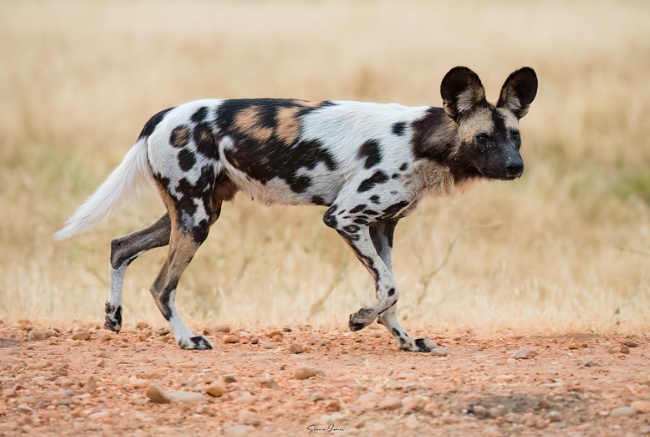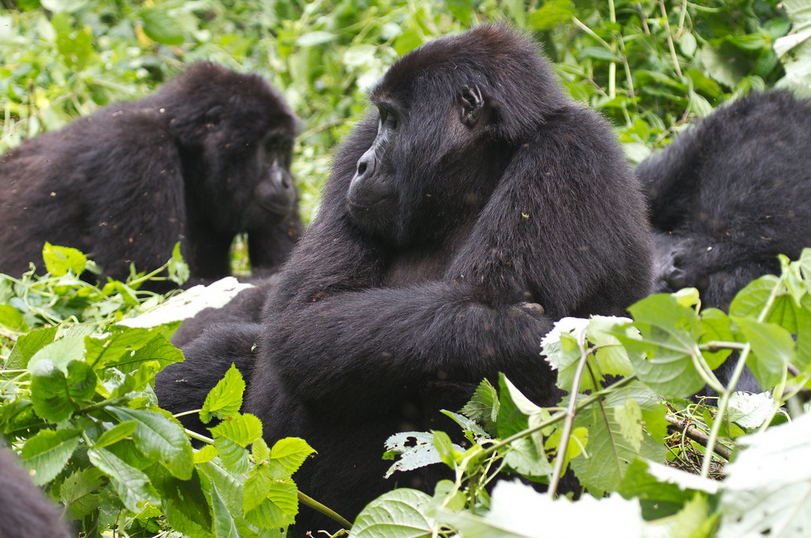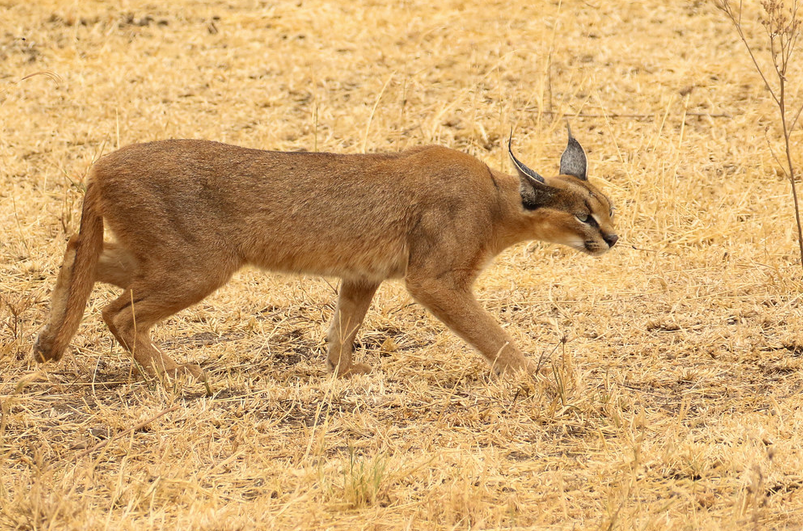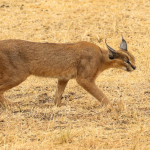The African Wild Dog
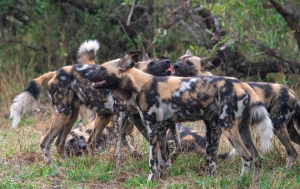
The African wild dog: (Lycaon pictus) also known as the African painted dog or Cape hunting dog, is a wild canine native to sub-Saharan Africa. It is the largest wild canine in Africa and has been listed as endangered on the IUCN Red List since 1990. Its natural competitors are lions and spotted hyenas. Like other canids, the African wild dog regurgitates food for its young, but also extends this action to adults. However, the young have the privilege to feed first on carcasses.
Subspecies of wild dogs
- Cape wild dog
The Cape Wild Dog is the largest, weighing 20–25 kg (44–55 lb) but much more colourful than the East African wild dog. It is characterized by the large amount of orange-yellow fur overlapping the black and partially yellow backs of the ears. Additionally, it has yellow underparts and a number of whitish hairs on the throat mane.
-
East African Wild Dog
This subspecies is distinguished by its very dark coat with very little yellow spots.
-
Somali Wild Dog
This subspecies is smaller than the East African wild dog whereby it has shorter and coarser fur and has a weaker dentition. Basically, its colour closely approaches that of the Cape wild dog, with the yellow parts being buff.
-
Chadian Wild Dog
Generally, this sub specie is brightly coloured with very short 15mm hair.
-
West African Wild Dog
The West African wild dog used to be widespread from western to Central Africa, from Senegal to Nigeria. Meanwhile, only two subpopulations survive: one in the Niokolo-Koba National Park of Senegal and the other in W National Park of Benin, Burkina Faso and Niger.
Description of an African Wild Dog
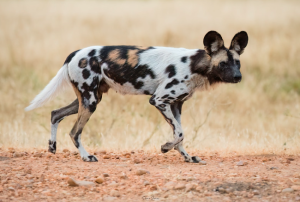
The African wild dog is the bulkiest and most solidly built of African canids. Females are usually 3–7% smaller than males. Compared to members of the genus Canis, the African wild dog is comparatively lean and tall, with outsized ears and lacking dewclaws. Adults gradually lose their fur as it ages, with older individuals being almost naked. Colour variation is extreme, and may serve in visual identification, as African wild dogs can recognize each other at a distances of 50–100m. The back of the head and neck are either brown or yellow. A white patch occasionally occurs behind the fore legs, with some specimens having completely white fore legs, chests and throats. The tail is usually white at the tip, black in the middle and brown at the base.
Distribution and habitant
African wild dogs once ranged across much of sub-Saharan Africa, being absent only in the driest deserts and lowland forests. A stable population comprising more than 370 individuals is present in South Africa, particularly the Kruger National Park. The African wild dog inhabits mostly savannas and arid zones, generally avoiding forested areas. Nevertheless, it will travel through scrub, woodland and montane areas in pursuit of prey. African wild dogs are occasionally sighted in other parts of Senegal, Guinea and Mali. In Central Africa, the species is extinct in Gabon and Democratic Republic of Congo. The African wild dog is distributed throughout patches in East Africa, having been eradicated in Uganda and much of Kenya.
Hunting diet
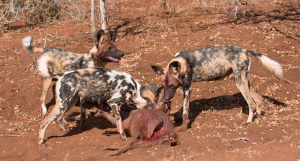
The African wild dog is a specialized pack hunter of common medium-sized antelopes. Male wild dogs usually perform the task of grabbing dangerous prey, such as warthogs, by the nose. More specifically, in East Africa, its most common prey is the Thomson’s gazelle eaten within 15 minutes. It also targets impala, reedbuck, kob, springbok and smaller prey such as common duiker, dik-dik, hares and insects. African wild dogs rarely scavenge, but have on occasion been observed to appropriate carcasses from spotted hyenas, leopards, cheetahs, lions, and animals caught in snares. Unlike most social predators, African wild dogs will regurgitate food for other adults as well as young family members.
Social and reproductive behaviour
The African wild dog has strong social bonds, stronger than those of sympatric lions and spotted hyenas; thus, solitary living and hunting are extremely rare in the species. It lives in permanent packs consisting of two to 27 adults and yearling pups. Males and females have separate dominance hierarchies, with the latter usually being led by the oldest female. Males may be led by the oldest male, but these can be supplanted by younger specimens; thus, some packs may contain elderly male former pack leaders. Furthermore, males in any given pack tend to out number females. Males rarely disperse, and when they do, they are invariably rejected by other packs already containing males.
Breeding
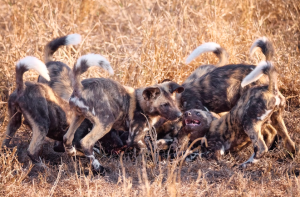
The gestation period lasts 69–73 days, with the interval between each pregnancy being 12–14 months typically. The African wild dog produces more pups than any other canid, with litters containing around six to 16 pups. Thus, indicating that a single female can produce enough young to form a new pack every year. After giving birth, the mother stays close to the pups in the den, while the rest of the pack hunts. The pups leave the den around the age of three weeks and are suckled outside. Once the pups reach the age of 8 to 10 weeks, the pack abandons the den and the young follow the adults during hunts. African wild dogs have an average lifespan of about 10 to 11 years in the wild. When separated from the pack, an African wild dog becomes depressed and can die as a result of broken heart syndrome.
Updates
The African Painted Dogs, which were thought to have become extinct in Uganda, have appeared in Uganda’s Northeastern national park. African Painted Dogs (commonly known as Wild Dogs) which went extinct in Uganda in the 1980’s, were sighted on 18th June 2023 around the Narus River in Kidepo Valley National Park, said Uganda Wildlife Authority (UWA) on Monday night.
“One of our resident rangers captured these images hastily before the pair skipped out of view”, said the authority. The wild dog is one of the world’s most endangered mammals. The Largest populations remain in southern Africa and southern part of East Africa (especially in Tanzania and northern Mazambique).
African Wild Dog facts
-
Sound
Like satellite dishes, the large rounded ears of African wild dogs swivel to detect minute sounds in the distance.
-
Toes
Another way African wild dogs differ from domestic dogs: They only have four toes per foot.
-
Markings
Like a zebra’s unique stripe pattern or a human’s fingerprint, no two dogs have the same markings on their coat. Mottled with red, black, brown, white, and yellow patches of fur, the effect is as striking as it is essential to survival.
-
Adventures in babysitting
A monogamous pair of alpha dogs leads each pack, with the whole crew caring for each litter of pups—from taking turns guarding and nursing the pups to regurgitating meat after a hunt.
-
Top dogs
With an impressive 80 percent success rate, wild dogs are among Africa’s most effective predators. Lions only prevail around 30 percent of the time.
-
Not man’s best friend
Even with their finely honed hunting skills, African wild dogs count among the world’s most endangered mammals. The biggest threats facing the species come from their increased contact with humans: habitat loss, villagers seeking revenge against killed livestock, and viral diseases contracted from domestic dogs.
-
Speed
Wild dogs can sprint after prey at speeds of up to 44 miles an hour.
-
No dog left behind
African wild dogs work together in packs of 6 to 20 or more to hunt antelopes and even larger prey such as wildebeests. These highly social beasts communicate with each other by touch, actions, and vocalizations—before a hunt, you can see them playfully circling each other and seeming to psych each other up for the endeavor. They’re also one of the few mammals that care for the old, sick, and disabled members of the pack.
-
Pack mentality
African wild dogs live and die for their family—literally. Though the bigger the clan the more efficient the hunt, non-breeding adults sacrifice their own nourishment to ensure the pups in the group get enough to eat and grow.

